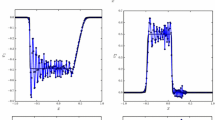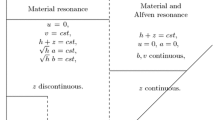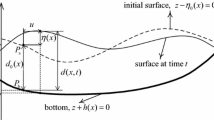Abstract
The dynamics of thin layer incompressible and electrically conducting fluids is described by shallow water magnetohydrodynamics equations (SWMHD), for which the evolution is nearly two dimensional and the magnetic equilibrium lies in the third direction. In this article, a space–time conservation element and solution element (CESE) scheme is extended for numerical investigation of one- and two-dimension shallow water magnetohydrodynamics (SWMHD) with variable bottom topography. The presence of non-conservative terms and the inclusion of variable bottom topography on the right hand side of SWMHD equations poses some major challenges for any numerical scheme. The proposed CESE scheme differs from the previous techniques because of global and local flux conservation in a space–time domain without restoring to interpolation and extrapolation. To check the validity of the scheme, a number of test problems are considered. The results are also compared with the already existing results in the literature by central-upwind scheme.







Similar content being viewed by others
References
Inogamov NA, Sunyaev RA (1999) Spread of matter over a neutron-star surface during disk accretion. Astron Lett 25:269–293
Gilman PA (2000) Magnetohydrodynamic shallow water equations for the solar tachocline. Astrophys. J Lett 544:79–82
Spiegel EA, Zahn J-P (1992) The solar tachocline. Astron Astrophys 265:106–114
De Sterck H (2001) Hyperbolic theory of shallow water magnetohydrodynamics equations. Phys Plasmas 8:3293–3304
Heng K, Spitkovsky A (2009) Magnetohydrodynamic shallow water waves. Linear Anal ApJ 703:1819
Schecter DA, Boyd JF, Gilman G (2001) Shallow-water magnetohydrodynamic waves in the solar tachocline. ApJ 551:L185
Zaqarashvili TV, Oliver R, Ballester JL, Shergelashvili BM (2007) Rossby waves in “shallow water” magnetohydrodynamics. A&A 470:815–820
Zaqarashvili TV, Oliver R, Ballester JL (2009) Global shallow water magnetohydrodynamic waves in the solar tachocline. ApJ 691:L41–L44
Toro EF (1962) Shock-capturing methods for free surface shallow fluids. Wiley, New York, vol 2
Zia S, Ahmed M, Qamar S (2014) Numerical solution of shallow water magnetohydrodynamic equations with non-flat bottom topography. Int J Comput Fluid Dyn 96:136–151
Qamar S, Zia S, Ashraf W (2014) The space time CE/SE method for solving single and two-phase shallow flow models. Comput Fluids 28:56–75
Powell KG (1994) Approximate Riemann solver for magnetohydrodynamics (that works in more than one dimension). Technical Report
Powell KG, Roe PL, Linde TJ, Gombosi TI, de Zeeuw DL (1999) A solution-adaptive upwind scheme for ideal magnetohydrodynamics. J Comput Phys 154:284–309
Evans CR, Hawley JF (1988) Simulation of magnetohydrodynamic flows a constrained transport method. ApJ 332:659–677
Brackbill JU, Baranes DC (1980) The effect of nonzero \(\nabla.\mathbf{B}\) on the numerical solution of the magnetohydrodynamic equations. J Comput Phys 35:426–430
Qamar S, Mudasser S (2010) A kinetic flux-vector splitting method for the shallow water magnetohydrodynamics. Comp Phys Commun 181:1109–1122
Xu K (1999) Gas-kinetic theory based flux splitting method for ideal magnetohydrodynamics. J Comput Phys 153:334–352
Croisille J-P, Khanfir R, Chanteur G (1995) Numerical simulation of the MHD equations by kinetic-type method. J Sci Comput 10:81–92
Kröger T, Lukáčová-Medvid’ová M (2005) An evolution Galerkin scheme for the shallow water magnetohydrodynamic (SWMHD) equations in two space dimensions. J Comput Phys 206:122–149
Tang H, Tang T, Xu K (2004) A gas-kinetic scheme for shallow-water equations with source terms. Z Angew Math Phys 55:365–382
Xu K (2002) A well-balanced gas-kinetic scheme for the shallow-water equations with source terms. J Comput Phys 178:533–562
Kurganov A, Tadmor E (2000) New high-resolution central schemes for nonlinear conservation laws and convection diffusion equations. J Comput Phys 160:241–282
Rossmanith JA (2002) A wave propagation method with constrained transport for ideal and shallow water magnetohydrodynamics, Ph.D. thesis, University of Washington, Seattle, Washington
Tóth G (2000) The \(\nabla.\mathbf{B}\) constraint in shock-capturing magnetohydrodynamics codes. J Comput Phys 161:605–652
Chang SC (1995) The method of space time conservation element and solution element—a new approach for solving the Navier Stokes and Euler equations. J Comput Phys 119:234–295
Chang SC, Wang XY, Chow CY (1994) New developments in the method of space-time conservation element and solution element-Applications to two-dimensional time-marching problems. NASA TM 106758.
Chang SC, Wang XY, To WM (2000) Application of the space-time conservation element and solution element method to one-dimensional convection-diffusion Problems. J Comput Phys 165:189–215
Chang SC, Wang XY, Chow CY (1999) The space-time conservation element and solution element method. A new high resolution and genuinely multidimensional paradigm for solving conservation laws. J Comput Phys 156:89–136
Zhang ZC, Yu ST, Chang SC (2002) A Space-time conservation element and solution element method for solving the two- and three-dimensional unsteady Euler equations using quadrilateral and hexahedeal meshes. J Comput Phys 175:168–199
Qamar S, Warnecke G (2005) Application of space-time CE/SE method to shallow water magnetohydrodynamic squations. J Comput Appl Math 196:132–149
Dumbser M, Castro M, Parés C, Toro EF (2009) ADER schemes on unstructured meshes for nonconservative hyperbolic systems, Applications to geophysical flows. Comput Fluids 38:1731–1748
Pelanti M, Bouchut F, Mangeney A (2008) A Roe-type scheme for two-phase shallow granular flows over variable topography. ESAIM-Math Model Numer 42:851–885
LeVeque RJ (1998) Balancing source terms and flux gradients in high-resolution Godunov methods: the quasisteady wave-propagation algorithm. J Comput Phys 146:346–365
Noelle S, Pankratz N, Puppo G, Natvig J (2006) Well-balanced finite volume schemes of arbitrary order of accuracy for shallow water flows. J Comput Phys 213:474–499. 40
Xing Y, Shu CW (2005) High order finite difference WENO schemes with the exact conservation property for the shallow water equations. J Comp Phys 208:206–227. 41
Author information
Authors and Affiliations
Corresponding author
Additional information
Technical Editor: Marcio S. Carvalho.
Rights and permissions
About this article
Cite this article
Saleem, M.R., Zia, S. & Qamar, S. A space–time CESE scheme for shallow water magnetohydrodynamics equations with variable bottom topography. J Braz. Soc. Mech. Sci. Eng. 39, 1563–1573 (2017). https://doi.org/10.1007/s40430-016-0678-4
Received:
Accepted:
Published:
Issue Date:
DOI: https://doi.org/10.1007/s40430-016-0678-4




